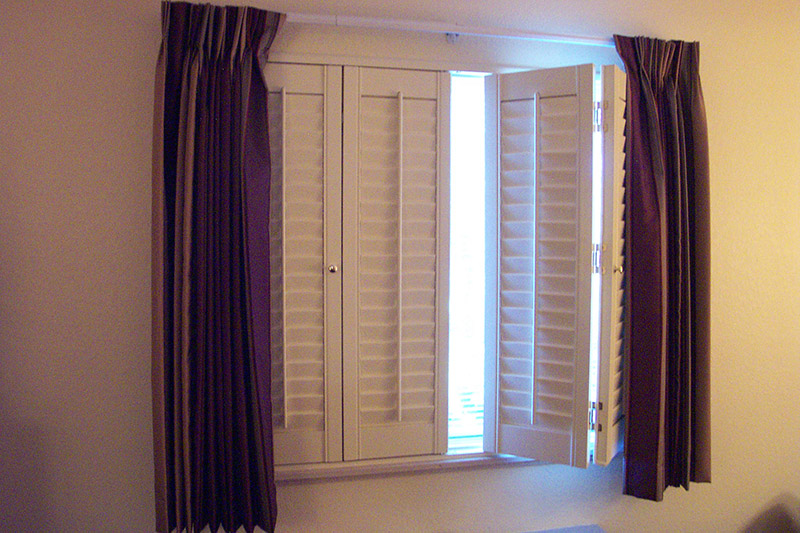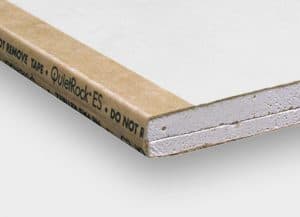COVID. Every cloud has a silver lining. Now you get to work at home. In your sweats. Except your home office is noisier than your ‘office’ office. Let’s solve that problem.
7 Ways to Soundproof a Home Office
If you do not have a decibel meter, now might be a good time to get one–to measure the noise in your office before you start. Sound Transmission Class (STC) ratings are a rough reflection of noise decibel reduction provided by a partition like a wall, door, window. Here is a list of STC ratings with real-world descriptions to help you understand what you want to accomplish.
- 25 Normal talking can be heard and understood through a wall.
- 30 Loud talking can be easily understood, and normal speech can be heard but usually
not deciphered. - 35 Loud talking can be heard but isn’t understandable.
- 40 Loud talking sounds like a murmur; it’s considered the beginning of “privacy.”
- 42 Loud talking sounds like a whisper.
- 45 Loud talking isn’t heard. However, music and heavy traffic may still be heard.
- 50 Very loud sounds like musical instruments and stereos are barely heard.
- 60+ Excellent soundproofing, even loud sounds are barely heard.
For more information, please go to Wikipedia – Sound Transmission Class.
1) The Door
The door is almost invariably your biggest soundproofing enemy. Hollow-core with an STC rating of about 20, no weatherstrip, no insulation, and a 1″ gap at the bottom. It can’t get much worse unless it isn’t there. For way more detail about soundproofing a hollow-core door, please see our articles How to Soundproof a Hollow Door and STC Ratings for Doors.
Change the Slab
Replace the slab with a solid wood, or solid core, door slab–preferably 1 3/4″ thick. For ease of installation, order it prehung (unless you like using routers, chisels, and hole saws). That way, you are going to rip out everything and get back to the rough opening, allowing you to install your new door level, plumb, and square. (Note: This door slab is way heavier than the one you removed, so make sure you replace at least one jamb hinge screw–in each hinge–with a 3″ deck screw.)
Replace the casing on one side, spray about 1″ of Great Stuff foam insulation against the back of it, fill the rest of the cavity with Roxul rockwool or fiberglass batt insulation (do not pack tight), and install casing on the other side. Congratulations. You have improved the STC rating to 30 – 35. It doesn’t sound like much, but the chart shows a big improvement.
Weatherstrip, Sweep, and Seal
Wherever air can move, noise can move. Interior doors usually do not have a weatherstrip or a sweep. Even the new one you just installed. Install Keliiyo Weather stripping on the doorstop to seal the gap around the slab perimeter. (Clean the stop with a 50/50 vinegar/water mix or TSP to ensure the adhesive sticks.)
Holikme Door Draft Stopper will take care of the gap under the slab. (Up to 1 1/2″). It is easy to install and will work on virtually any floor covering. (If you have rug, I would recommend spraying the bottom with Dry Silicone Lubricant every year to reduce friction.)
Note: If you have chosen not to replace the slab but to use a covering instead, make sure you take this step. A lot of noise will pass around and under the door slab.

Cover It
Soundproof blankets, curtains, or purpose-made coverings will cut down the noise.
- Sound Absorbing Blankets. Better known as moving blankets can be hung over the door. They will absorb and deaden incoming noise. (You may want a grommet kit because most of them do not have grommets.) Most of them are 72″ wide x 80″ high, which is a little short to cover the door all the way to the floor. US Cargo Control sells an 80″x 96″ heavy blanket with grommets. Way too wide, but with scissors and a little sewing to close the cut side, you can do 2 doors. Hang from hooks near the ceiling and ensure it touches the floor for complete coverage.
- Nicetown sound-reducing Curtains. These will also reduce noise and are easier to deal with than blankets. Hung from a curtain rod installed above the door, with the use of curtain holdbacks to keep them out of the way, they make an attractive addition to soundproofing your home office. Many sizes and colors are available.(Note: The pleated design allows noise to travel over the curtain.)
- AcoustiDoor. Manufactured by Residential Acoustics. These are a roll-up covering that hangs from hooks above the door with magnets or Velcro to seal the sides to the walls. Available in many sizes and colors. Blocks up to 30 decibels which translates to 87% of incoming sound. More expensive than blankets or curtains, but if it looks like your home office will become your permanent office, they may be well worth the investment. Once and done.
Note: All of these products are usually installed on the inside of your door, which is generally opens into the office. Make sure you consider how you are going to open the door and get in and out easily when choosing your door treatment.
2) The Window
By far, the best window soundproofing option is to remove it and build a wall. If you consider this a dumb idea, use one, or both, of the following suggestions.

Replace the Window
Replace the complete window with a triple-glazed unit. If you can get it with one pane of glass laminated, you have even better soundproofing. (I have installed many triple glazed windows, and invariably, the customer’s first comment is how much quieter they are.) A triple pane window with laminated glass, 1/2″ air spaces, Low E coatings, and Argon gas filled will reach an STC rating of around 39. Please see our article STC Ratings for Windows for more information.
If you are doing the job yourself, make sure you insulate the cavity between the window frame and wall framing with about 1″ of spray foam and complete it with Roxul rockwool or fiberglass batt. (Do not pack it tight. Packed tight is almost worthless–both as insulation and soundproofing.)
Cover It
- AcousticCurtain. Manufactured by Residential Acoustics are a roll-up covering that hangs from hooks above the window with magnets or Velcro to seal the perimeter to the walls. Available in many sizes and colors. Blocks between 21 and 25 decibels which translates to 60% – 80% of outside noise.
- Shuteye Shutters. Manufactured by Quietly Making Noise will reduce exterior noise by 25 – 50 decibels. Custom-made to fit your measurements in many styles and colors. If you want a soundproof window that allows light and air, take a good look at these. Usually more expensive than other options.
- Other Options. For less expensive options, consider soundproof blankets, Nicetown soundproof Curtains, or an old quilt or blanket you may have around the house.

3) Fill Gaps and Cracks
- One of the sneaky noise infiltration points is the wall sill plate sitting on the floor. Remove your baseboard and apply a quarter-inch thick bead of acoustic caulking all along the join. (Re-attach baseboard.)
- Seal all casing and baseboard to the wall with paintable caulking.
- Remove all electrical covers and light fixtures and caulk between the boxes and drywall. Re-install the covers with Trade Gear Wall Plate Gaskets.
- Seal any cracks in the wall with paintable caulking.
- Remove all HVAC covers and caulk the gaps between piping and drywall. If the gaps are too big for acoustic caulking, fill them with Great Stuff foam insulation or pack them with fiberglass batt. As long as there is some kind of backer in the gap, you can get acoustic caulking on it–even if you use a small putty knife.

4) Soundproof the Structure
For a truly soundproof office, you will need to build a room-within-a-room. (Please see our article How to Build a Soundproof Room-Within-a-Room.) Or you can incorporate some of the strategies below.
Floor Soundproofing
If your office does not have anyone below you (like your basement), it is really not necessary to concern yourself. Otherwise get a good wool rug and lay it down over 1/2″ thick RugPadUSA soundproofing underlayment. Even if you have an existing rug, just put the new rug and underlayment over the top. Liberal use of double sided carpet tape, along with a Heavy Duty Polycarbonate Chair Mat should keep everything in place, and undamaged.
Another option is BalanceFrom Puzzle Exercise Mat made of high density EVA foam up to an inch thick. Will deaden Impact Noise along with room sounds and echoes.
Ceiling Soundproofing
If there is no living space above your office, the only thing you may have to worry about is some Flanking Noise passing into the attic from other parts of the house. On the other hand, if noise is coming from the floor above, you need to deal with it. In your own house you can just soundproof the floor in the room above with a heavy wool rug and RugPadUSA underlayment or BalanceFrom Puzzle Exercise Mat.
But if you live in an apartment or condo, it gets a little more tricky. Because you will probably need someone’s permission to add isolation clips c/w hat channel, and soundproofing drywall like QuietRock or Certainteed. This is a more expensive and labor-intensive option, but if you are going to work comfortably in your office for a year or better, it could be well worth the effort.
If the noise is bad, you might be able to deal with the upstairs neighbor and split the cost of a new rug and underlayment in the apartment above you.
 QuietRock Soundproofing Drywall
QuietRock Soundproofing Drywall
5) Technological Soundproofing
Earplugs have been around forever, and qualify as a fairly low tech solution. Annoying. But they work. Some have a Noise Reduction Rating of 33 decibels. For those a little more tech-savvy than I am, give some consideration to the following options.
Sony WH1000XM3 Noise Cancelling Headphones
Sony WH1000XM3 Noise Cancelling Headphones claim to reduce ambient noise by 90%. These inexpensive units will keep the noise down while letting you listen to music you like. There are expensive, but they work with Alexa, and you get what you pay for with this option. Get all the bells and whistles like a Quick Attention Mode and much more. They fold for easy storage and include adapters and a storage case too to keep them safe.
Sony WH1000XM3 Noise Cancelling Headphones
White Noise Machines
White noise machines mask noises by producing soft, comforting sounds. As long as the volume of the noise you are trying to block is lower than the sound produced by your white noise machine, you will not hear them. Lectrofan produces 20 sounds that mask intrusive noise. Inexpensive and effective.
Black Noise Machines
Get a Black Noise Machine, which means your office stereo will put out more decibels than anything else in the house. Problem solved–except for permanent hearing loss.
 Decibel Level Comparisons
Decibel Level Comparisons
6) Add Furnishings and Books
Adding any type of mass to your office will damp incoming sound. For instance–my office is full of shelves, books, computer paper, desks, filing cabinets, computers, shredders, and anything my wife can sneak in here without me knowing–like her sewing basket. I want anything I use regularly near to hand, and you probably do also. Think of it as soundproofing–not clutter. You’ll feel way better.
7) Eliminate Echoes
If you have done all of the other soundproofing to the best of your ability, adding acoustic treatment will not reduce incoming sound. It will cut down on room echoes, and help keep sound inside the office. Dekiru Soundproofing Panels are decorative, inexpensive, and efficient. Installed with double sided tape or spray glue.
Note: You only need to do 30% of the wall area to get good sound absorption and echo reduction.
End Notes
I am enjoying working from home. There is one big downside. I am way too close to the cookie jar and refrigerator.

